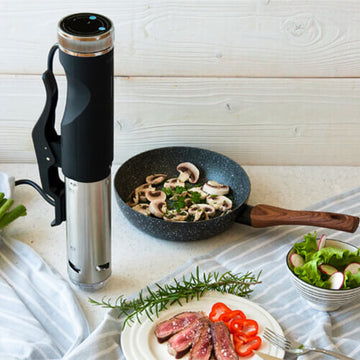TAKE PRIDE IN SOUS VIDE
Many world-class chefs including Thomas Keller are now using the sous vide cooking method to yield moist and flavourful dishes. By sealing in all the nutrients and flavours, the meals resulting are nearly impossible to achieve by traditional means. However, these professional chefs often use high-end, thousand-dollar immersion circulators that insulate and regulate the temperature of the water throughout the cooking process. Food Vacuum Sealers Australia, food vacuum sealers are once again bringing professional quality into your domestic environment. So take pride in sous vide
Cooking sous vide is easier than its fancy name might suggest. Probably the most intriguing uses for food vacuum sealers, “sous vide” cooking is French for ‘under vacuum’. It is a revolutionary method of cooking in which food is vacuum sealed, then placed in a water bath or in a temperature-controlled environment.
The procedure itself is relatively straightforward. Place the raw food into a vacuum bag and seal. Submerge the bag in water that is the temperature you want your finished dish to be and presto. Perfectly and evenly cooked food every time!
What are typical sous vide cooking times
Depending on the cut, type, and thickness of food in question, cooking sous-vide for several hours is not out of the ordinary. Sous vide cooking times can range from as little as 30 minutes (for lean fish, foie gras, scrambled eggs) to as long as 72 hours (spareribs, tough meats). How long it takes a given potion of food to come to temperature depends on the thickness of the portion, not the total weight. Here’s a quick reference guide:
- Meat – 49 degrees for rare, 56 degrees for medium rare, 60 degrees for medium, and 65 degrees for medium well.
- White meat poultry – between 60 degrees up to 71 degrees as desired
- Dark meat poultry – 80 degrees
- Fish – 47 degrees for rare, 52 degrees for medium rare or 60 degrees for medium
- Shellfish – 56 to 60 degrees
- Vegetables –85 degrees
- Eggs – 64 degrees for soft boiled or 75 degrees for hard boiled
- Cakes – 88 degrees
- Custard –76.5 degrees
Remember, sous-vide cooked foods can be held at their specified temperature for long periods of time without diminishing the quality or texture of the dish. It’s therefore the ideal method for holiday meal preparation with multiple components and side dishes.
How does this influence flavour?
The sous vide cooking method locks in food’s natural flavours and prevents loss in the pan or air. Therefore, seasoning can be lighter than with other methods, saving you money. Cooking in sealed bags at lower temperatures also results in juicier food. There’s no substantive transfer of moisture from the food (like in poaching or broiling) and the cooking temperatures doesn’t get high enough for the food to dry out.
The crux of the process is in controlling the temperature of the water. Heating food without oxygen can contribute to the growth of some pretty nasty bacteria, including the bacteria that causes botulism. To avoid this, follow basic kitchen protocol of clean surfaces, no cross contamination and properly cook the food. Bear in mind the length of time you’re holding the food at its safe temperature will pasteurize meat to ensure its safety. Also if it’s undercooked, there’s no problem! Just seal the bag up again and put it back in.
Sous vide has taken all the guesswork out of cooking. ‘Safe’ meat now doesn’t have to equal ‘dry’ or ‘not pink’ any longer. By nature, sous-vide cooking is also a repeatable process. Set the temperature, set the timer, and walk away. You will wind up with perfectly cooked food every time!
Now you can take pride in sous vide cooking







